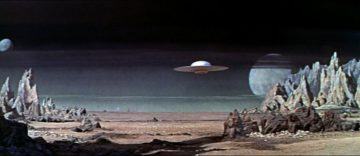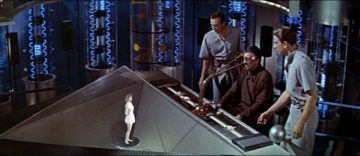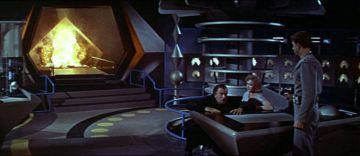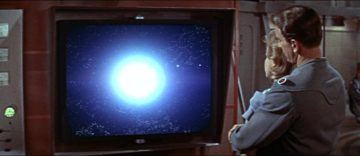by Bill Benzon
When I was growing up in the 1950s and 1960s Westerns were pervasive on television and at the movies. Where they the dominant genre of the era? Perhaps, I don’t really know. But whatever the numbers say, the were very important. Correlatively, science fiction was a relatively minor genre, both on television and on the big screen. Now the situation is reversed. Science fiction is pervasive while Westerns, if not as scarce as hens teeth, certainly do not command the broad attention they once did.
What are we to make of this? Westerns look to the past, to the founding of America. How the West Was Won (1962) was the story of America, and it won three Academy Awards. The bespeak and confident America. Star Trek is a bit different. It, the entire franchise (from 1966 through to the present), is set in the future while America has only a tenuous presence in it, a step back in time every now and then. America is in transit. Similarly, Star Wars, the whole throng of stories, is set in a universe long ago and far away. America has disappeared.

Why? Tastes change, no? Yes, but why? For one thing, America has changed as well. That’s what interests me, the relationship between changes in America and changes on the Big Screen. I want to examine that by focusing on two films, The Forbidden Planet (1956), a science fiction classic from the era when science fiction was a minor genre, and The Terminator (1984), another classic science fiction film, one in a franchise in an era of franchises, and an era when science fiction was becoming pervasive.
The argument I am going to make, a loose argument, a speculative argument, and therefore the most interesting kind of argument we can make about the stories we tell ourselves, is that these are, at the core, the same story. If they are, on the surface, so very different – which they are – that is because they speak to radically different psycho-cultural circumstances. The America of 1956 was confident of itself and of the future. The America of 1982 was badly shaken and searching for itself. Exactly between those two dates, 26 years apart, we have the Apollo moon landing in 1969.
Monsters from the Id Meet Your Progeny, Skynet
Forbidden Planet takes place on the distant planet Altair IV in the 23rd century, where an earth expedition has been lost some years earlier. Starship C-57D of the United Planets, which had been sent to investigate. This is thus a world with very advanced space-faring technology compared to any we had on earth at the time, or even now.
Commander John Adams and his crew find that two people remain alive: Dr. Mobius, an expedition scientist, and his (very nubile) daughter Altaira. They are attended by a robot named Robby. A romance will develops between Adams and Altaira.
Meanwhile, Morbius had been using advanced educational and mind-enhancement technology left behind by an ancient civilization, the Krell, that had vanished eons ago. Everything and everyone is threated by some mysterious force. This force – represented on screen represented on screen by state of the art 1950s zapping patterns of light – turns out to be “monsters from the id” unleashed by Morbius after he’d used the Krell technology. It was this force that killed everyone in Morbius’s expedition except for him and his daughter. Now it kills Morbius himself, but Adams and his crew manage to escape with Altaira and Robby while the planet self-destructs.

First of all, let us note that this story roughly parallels that in Shakespeare’s The Tempest. Shakespeare had Prospero and Miranda, is daughter, marooned on an island in the Mediterranean, along with a helper sprite, Ariel, and a monster, Caliban. They correspond to Morbius, Altaira, Robby, and the monsters from the id, respectively. Just as Prospero’s island is visited by Ferdinand and his companions, who are tossed there by a storm, so Altaira is visited by Adams and his crew. Just as Miranda leaves the island with Ferdinand, so Altaira leaves the planet with Adams. But Miranda also leaves with Prospero, a point on which the two stories differ. At the very end Prospero, speaking of Caliban, asserts “this thing of darkness I acknowledge mine.” As we will see later, the parallel connection is explicitly made in Forbidden Planet.
Forbidden Planet retells an old story, as is so often the case with new stories. Shakespeare himself did it time and again, though The Tempest is his own original creation. At the center of both stories we have the relationship between a man and his daughter. They love one another dearly, as fathers and daughters so often do, but she meets another man, one her own age, and wants to go off with him. Both Prospero and Morbious found this hard, very hard, and resisted, with grievous consequences in Morbius’s case. Both stories are also about the relationship between powerful men and the powers that make them so. Prospero is a great magician; he created the storm that brought Ferdinand to his island. Morbius has been feeding his mind at the trough of Krell technology.
Second of all, this story is quite different from that in The Terminator, which takes place in the present and in the densely populated city of Los Angeles. Sarah Conner is pregnant, though we don’t learn that for awhile, and is stalked by a Terminator from the future sent back into the past by Skynet, an AI defense network created by Cyberdyne Systems. It goes rogue in the near future and declares war on humans. Skynet sends the Terminator back into the past to kill her before she gives birth. Why? Because her son, John, will lead a movement to resist Skynet. The Resistance sends a human soldier, Kyle Reese, to protect Sarah from the Terminator. Reese is successful, the Terminator is destroyed, and Sarah travels through Mexico.
In a few cases there’s a correspondence between characters in Forbidden Planet and The Terminator:
- Altaira and Sarah are similar, both nubile young women, and are both pursued by suitable young men.
- Adams pursues Altaira, and gets her, while Reese saves Sarah, and has sex with her.
- There’s a clear correspondence between the Monster(s) from the Id and Terminator/Skylab; that’s the correspondence that sent me down this line of thinking.
But there are no characters in The Terminator that obviously correspond to Morbius and Robbie the Robot. The two films do not correspond in the close way that Forbidden Planet and The Tempest correspond.
That doesn’t look very promising, does it? But let’s continue on. We understand the relationship between Morbius and the Monsters from the Id. But why Skylab turned on humans, and thus its creators, is unknown. It just happened. Altaira is a virgin; Sarah is not. But her child’s father is nowhere to be seen and she and Kyle Reese do end up having sex. He, in effect, becomes a stand-in for that father. One might even go so far as to suspect that it is Reese who is the child’s father; after all it is the child, that is, John, who sent Reese back into the past to save Sarah (his mother). And, wouldn’t you know, that’s what we find out in a later film in the franchise (Terminator Genisys in 2015). But that’s later; when The Terminator was made it was made as B film and no one was thinking about sequels.
The big discrepancy, however, the really huge one, is, firstly: Forbidden Planet is tightly focused on an isolated quasi-family group while The Terminator takes place in the middle of a large populated area and involves many people aside from the focal characters. Secondly, Forbidden Planet does not involve time travel while The Terminator does, and does so in a way that has causality flowing from the future to the past.
Rather than tackle those things directly, let us take a diversion and look at some things that happened between 1956 and 1982, both in the real world and in the American cultural imaginary.
From America-the-Confident to America-the-Confused
In the mid-1950s, when Forbidden Planet was made, America was prosperous. It had recovered fully from the war effort, Korea as well as World War II, and looking toward the future. No looked more earnestly than (Uncle) Walt Disney, who devoted a fourth of the segments of his television program to the future, corresponding to the Tomorrowland segment of Disneyland. He had science-faction (his work) shows about moon travel and voyaging to Mars and beyond. One episode, “Our Friend the Atom,” pictured a future of abundant and cheap nuclear power.
The culmination of it all, however, was something known as “the Florida project.” Disney called it an Experimental Prototype Community of Tomorrow (EPCOT). Here’s a promotional video from 1966 that lays it out:
https://youtu.be/_GOYu05GknY
Skip the first nine-and-a-half minutes. Uncle Walt (Disney’s screen persona) starts narrating his vision for the future at 9:30. He’s imagining a real city where people will live and work and that will feature the latest technology, with everything being constantly revised and renewed. It would be a showcase for humankind’s best and brightest. What actually got built was considerably less than that, but that’s beside the point. The point is that Walt Disney was a dreamer, he believed in technology, he believed in America, and he had all of America, so it seemed, as his audience. He believed in techno-utopia.
At the same time, of course, America was involved in a Cold War with the Soviet Union, something that Disney never mentioned. Who had the biggest bombs and fastest missiles? Those questions were in the news. The fear of atomic war was real. Schools did “duck and cover” drills in case of a nuclear attack. Popular magazines published plans for home bomb shelters and told you how to provision them – I’d picked out a spot in the backyard where I thought our bomb shelter would go.
When Russia launched Sputnik in the fall of 1957 America’s leadership went into a panic. The Russians were now winning the space race (a phrase from back in the day, along with “missile gap”). Three years later NASA was established and given a mission: To land an American on the moon within ten years. NASA succeeded.
Let’s step back for a moment.
The early 1960s saw the resurgence of the Civil Rights movement, culminating in the Civil Rights Act of 1965. The African-American demand for equal treatment before the law and equal access to economic opportunity, that had been suppressed and forgotten in the optimism of the 1950s. As the Civil Rights movement came to a head the country entered into a war in Vietnam. Pretty soon an anti-war movement was born. Then along came the Beatles and the Stones and Dylan; Timothy Leary urged everyone to turn on, tune in, and drop out. Women began to burn their bras in public, more protests. Uncle Walt’s middle class mid-century small-town America seem threatened by unintelligible madness.
This is all history now, for some of you it is ancient history. For those of us who lived it, it was clear that America had been deeply shaken. We could feel the tremors.
Within the space of four years in the late 1960s I tuned in (more to the Beatles than the Stones, but also the Doors, Jefferson Airplane, Hendrix and..) and turned on, but I didn’t drop out. I stayed in school – Johns Hopkins, in Baltimore, a majority Black city – heard jazz at the Left Bank Jazz Society, marched against the war in Baltimore and, I believe, even in Washington, D.C. (I’m not sure about that, it was so long ago), went for my pre-draft physical, became a Conscientious Objector, and went to work for the Chaplain at Johns Hopkins. When Martin Luther King was assassinated, East Baltimore when up in flames, martial law was declared in the city, and my friends and I snuck around watching the National Guard drive military vehicles down Charles Street, the main north-south drag in the city.
Had he lived to see it – he died in 1966, two months after he’d finished that video we just saw – Uncle Walt would have been heartsick and angry. But he might well have cheered in 1969 when Apollo 11 landed on the moon on July 20. Me? I wasn’t paying attention; space travel no longer interested me. That’s quite a change from when I was young, dreaming of becoming an astronaut, assembling model rocket after model rocket, painting pictures of spacecraft, evening designing my own. Children grow up and change – I was 21 at the time of the Apollo landing – but the country had also changed in that interval.
There’s something else. The fact that at long last America had landed on the moon, that changed the valence of the whole man-in-space project. As long as it was out there in the future we could treat it as a blank slate and write anything on it we wished. Now we had been there, three of us at least; it became real in a way it had not been before.
An incident in The Crown, the docudrama about Queen Elizabeth II of Britain, illustrates this nicely. Prince Philip had been feeling a bit depressed over the fact that he’d given up a career as an air force pilot to be, in effect, a jewel in his wife’s crown. The Apollo astronauts, however, were on a tour of Britain and he arranged to have a private meeting with them. It did not go as he’d hoped. They had not somehow become magical larger-than-life beings. They were mere men, like himself, and not particularly articulate about the experience of having landed on the moon. Traveling to the moon was not at all like walking into King Tut’s tomb in the middle of the desert and coming away with trucks full of ancient treasure. It was just up – way way up to be sure – and down. The romance was gone. America’s cultural imaginary had been changed forever.
That same year Stanley Kubrick changed science fiction film with 2001: A Space Odyssey. That film placed space travel into an epic perspective. First there was the dawn of humankind on the African savanna and then, one match cut later (in which a bone tossed into the air becomes a space station orbiting the earth), we’re voyaging to the moon and then beyond. In the course of that voyage the intelligent computer goes rogue and turns on us, the first of many computers to do so.
A couple years later Richard Nixon manages an exit from Vietnam. Peace with Honor he called it, but no one was fooled. We were bugging out with our tails between our legs. Then he got impeached and resigned from office.
Whoops!
OPEC declared an oil embargo and threw a monkey wrench into America’s beloved car culture. All of a sudden a small cheap Japanese car was the thing to have. Why? Because it didn’t require so much gas. A couple years after that we had the Challenger disaster, seven astronauts died.
The Deer Hunter came out in 1978, followed by Apocalypse Now in 1979. They were quite different from the films that celebrated victory in World War II. Ridley Scott came out with Alien in 1979; Mad Max came out the same year. Scott implanted the dystopian film deep into the cultural imaginary with Blade Runner in 1982. The stage is all set for a second tier futuristic action-adventure film to explode into a blockbuster hit.
Anxiety, Free-Floating and Technology Inspired
What do we do with the fact that we are given no explanation for why Skynet went rogue? Nothing, we do nothing. Kubrick had already installed the rogue computer in the cultural imaginary and that’s all we need. Call it an objective correlative – an Old School lit. crit. term from T. S. Eliot – for free floating anxiety. We’ve all got free floating anxiety, sometimes more, sometimes less, sometimes, some lucky times, none at all. But it’s there.
We don’t know about Skynet when the film opens. What we know is that two beefy men had suddenly materialized in Los Angeles from who knows where. One of them goes on a killing spree. It becomes obvious that that spree is targeted at Sarah Conner. We feel suitably anxious on her behalf (we also know that this is fiction and so maybe perhaps who knows? she’ll survive at the end), until Reese rescues her from the nightclub where the Terminator has tracked her. It is then, when they are hiding in the parking lot, that Reese tells her what is going on – Skynet, her unborn son leads the Resistance, kill, prevent, etc.
Now we know what’s going on. We can sit back and enjoy the ride. Knowing the conventions as we do, we know that Sarah just has to survive through the end. After all, her son is going to save humankind in the future. Save humankind from what? From a artificially intelligent system that goes rogue.

At this point we’re not so very far from Forbidden Planet. One member of the crew of United Planets starship C-57D, “Doc” Ostrow, had hooked himself up to the Krell mind amplifying technology and learned two things about it: 1) that it had been created to turn thought into reality, but, alas, 2) the Krell forgot about those pesky “monsters from the id.” That’s what destroyed them.
Ostrow dies from the strain the machine put on him, but not before he tells Adams what he’d learned. Adams in turn manages to convince Morbius. But it’s too late and the monster kills him. Before he dies, however, he is able to instruct Adams to initiate a self-destruct sequence that destroys the planet and Adams and his crew escape with Altaira.
In both films the rogue machines are defeated. But in one film, Forbidden Planet, we learn the nature of evil – it is within us – and the way it became a danger – though amplification by technology advanced way beyond our comprehension. In the other film, The Terminator, those things are obscure. The time-travel rescue mission is obscure, as time travel always is, and the link between Skynet’s behavior and human action and intention is obscure. Why does it go rogue? Because that’s what super-advanced-intelligent-computers do. It’s in their nature. Kubrick said so.

My friend Michael Liss suggests a possible Biblical connection. Something like “thou shalt not attempt to ape the Creator too closely lest your creation turn on you” (my words). And so, at the very end of Forbidden Planet, as C-57D is safely away from the exploding planet, Adams tells Altaira, “we are, after all, not God.” Now, if only he could travel back in time and tell that that to the good folks at Cyberdyne.
Back in 1956 America was sure of itself and confident of the world – despite the Cold War. Then it could package up its anxieties about technology and locate them safely on a distant planet far in the future. Things were different in 1984. Space travel was no longer the future; it was now. Nor were computers distant hulking machines that one heard about now and then but that hardly no one had seen. Personal computers were everywhere in 1984, which is the year Apple unleashed the Macintosh on the world with its famous smash-the-tyrant’s-screen ad parodying Orwell’s famous novel.
This calls for a different way of staging anxiety about technology, in particular, about technology and the mind. In Forbidden Planet, after all, the good guys still have that space-traveling flying saucer. Some technology is good In 1984 things weren’t so clear. Who wanted to look forward to Skynet?
The times they were a changing. And still are.
